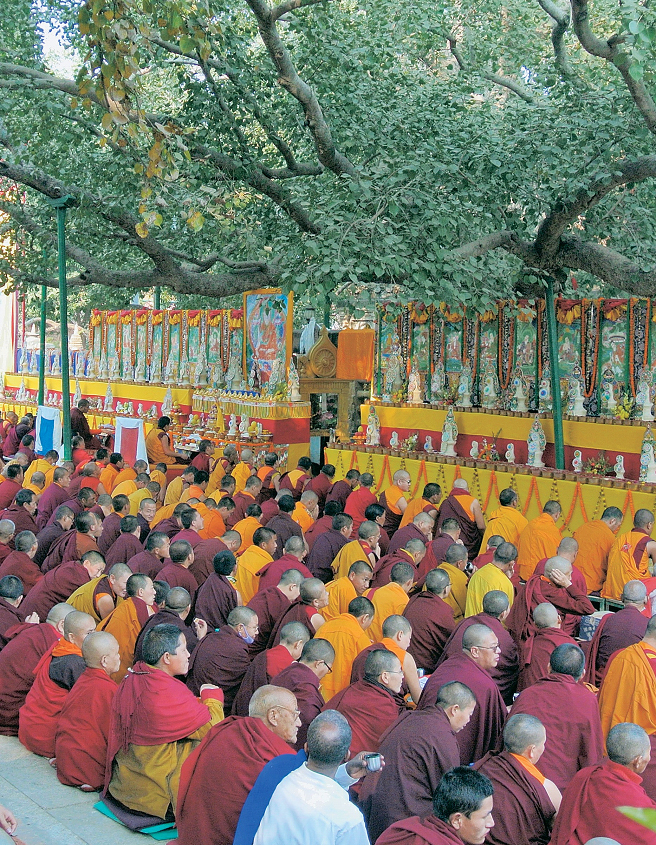Reports From The Mandala
Head Lama of TNMC

Over the past decade, the Nyingma Mandala of Organizations has expanded dramatically and in unexpected ways. Existing organizations have continued their activities on behalf of the Dharma and all sentient beings, typically intensifying their efforts. At the same time, at least nine new organizations have been formed, adding new dimensions to the founding Head Lama’s vision.
In the reports that follow, we lay out recent developments throughout the mandala and introduce the work of our new organizations. We start with the work of TNMC, where the Head Lama is most directly involved: Yeshe De, Odiyan, the Light Foundations, and the Sarnath Institute. From there we move on to describe the structure and mission of the Nyingma Association of Mandala Organizations (NAMO), founded in 2011.
We go on to lay out the recent work of the organizations that belong to NAMO. As a structure for presenting this wealth of developments, we start with the organizations located in Sonoma County, then turn to developments in Berkeley, and finally report on the expanding efforts of our international centers, under the direction of Nyingma Centers.
World Peace Ceremony
The 2014 World Peace Ceremony (also known as the Nyingma Monlam Chenmo, Great Nyingma Prayer Ceremony) marked the twenty-fifth time that lamas, monks, nuns, and lay people from throughout India and the Himalayan regions had gathered together to pray for peace. When Tarthang Tulku organized the first ceremony in 1989, his intention was to honor the wishes of his root guru, who viewed prayers at Bodhgaya as a source of powerful blessings for the entire world. When various obstacles arose to Rinpoche’s efforts to sponsor prayer ceremonies at this most sacred site, he decided to return to India himself to organize the ceremonies.
That first year, about 500 lamas and monks participated. The event was such a success that they requested Rinpoche to organize a second ceremony, and after that it became an annual event. For the first few years, TNMC played the central role in organizing the ceremony and sponsoring the costs, but soon the Nyingma community in exile took responsibility for the planning and administration.
The World Peace Ceremony has become a strong focus for the Nyingma community in exile. Never in history had such an assembly been held, but with the community of practitioners dispersed across several countries and cut off from their traditional sources of support, it soon became clear that such a gathering could contribute greatly to building the ties of community and offering support to the Sangha. Today, from 7,000–10,000 lamas, nuns, and monks participate in the Monlam each year, together with thousands of lay Tibetans, making this one of the world’s largest gatherings of the Sangha. Representatives of more than three thousand schools, monasteries, and retreat centers attend the Monlam annually, led by great masters of the Nyingma tradition. Western Dharma students also find special inspiration in attending such an awe-inspiring convocation.
The impact of the World Peace Ceremony has been felt throughout the Buddhist world. The new energy that the Monlam brought to Bodhgaya helped revitalize the community and the sacred Mahabodhi Temple, which today is recognized as a UNESCO World Heritage Site. TNMC and the organizations that operate under its auspices have helped restore the grounds of the temple, built butter-lamp houses and sponsored the burning of butter lamps year round, regilded the Mahabodhi spire, installed prayer wheels and plaques bearing sacred texts, and done much to improve the lives of local residents. Responding to these positive changes, other Buddhist communities have begun holding their own ceremonies at Bodhgaya, so that it is truly becoming a center for the blessings of the Buddha’s realization to be released.
From the very first, the World Peace Ceremony has served as the focal point for distribution of Tibetan texts prepared by the Yeshe De Project. In the first year, only a few hundred volumes were prepared, but now hundreds of thousands of books are distributed each year. As texts become available to students and practitioners and make their way to centers throughout the Tibetan diaspora (and even inside Tibet itself), communities discover new ways to connect with the tradition, students focus with new clarity on the classic curriculum of study, literacy increases, and nuns find the opportunity to study at advanced levels that in the past were not available to them.
At the 2014 ceremony, distribution of texts, which has grown too large to manage at the temple grounds, was carried out at the Kalachakra Maidan, an open field a short walk away. As usual, volunteers from our own centers spent the afternoons helping make sure the distribution ran smoothly and the mornings helping with offerings and carrying out their own practice.
Some years ago, Rinpoche instituted a second ceremony at Sarnath in honor of the great Nyingma master Longchenpa, whose Parinirvana anniversary comes just a few days after the close of the Monlam. After a few years it proved too difficult for monks to make the journey from Bodh Gaya to Sarnath, and the Longchenpa sadhana was moved to Bodh Gaya as well. Now that the Sarnath Institute is operating, however, the logistics are easier to manage, and this year the Longchen Varna, as Rinpoche named it, returned to Sarnath. Participants received the Kanjur prayer wheels described elsewhere in this issue.